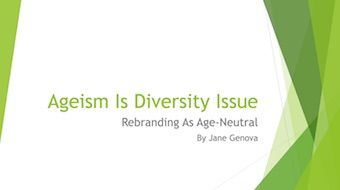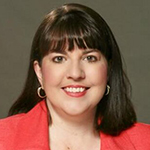 Jane Genova |
Workplace diversity Issues, ranging from race to gender, have long been high profile threats to the brand. Ageism has been the exception—until now.
One obvious sign that ageism should currently concern companies is the litigation. “Rabin v. PwC” contends recruitment on college campuses prevents hiring of the over-40. And “Mullaugh v. JPMorgan” claims that broker Michael A. Lorig’s suicide was caused by being forced into retirement.
Another red flag is government involvement. In 2016, the most recent year for statistics, the Equal Employment Opportunity Commission received 20,857 claims of age discrimination.
A third is the growing number of retirees who want or need to work. According to the Federal Reserve Board, one-third of retirees return to the labor force. More may have to. The Employee Benefit Research Institute found declining confidence among retirees in their ability to pay their bills. If they can’t find appropriate or any work, they could become the loudest voices in the room.
 |
Any one or a combination of these factors could trigger a crisis for a company or business in general. Public relations firms can prevent that by conducting a quick ageism audit for clients, allowing them to rebrand as age-neutral. Here you can download a complimentary copy of my new book - “Ageism Is a Diversity Issue: Rebranding as Age-Neutral” - which contains an audit template.
At a minimum, the audit must cover four categories.
Language
Language is the visible layer of the corporate culture. Words and phrases which reflect conscious or unintentional age bias get the attention of all constituencies, be they lawyers or the media.
No-Nos include:
- “Young.” Replace with “energetic,” “innovative,” and “cool.”
- “Recent college graduate.” Replace with “X years of experience or entry level.”
- “Overqualified.” Replace with “this position requires X years of experience and no more.”
- “Knowledge of technology.” Replace with specifications about the software requirements, such as “This job demands advanced level Excel expertise.”
- “Baby Boomer.” Replace with “multi-generational workforce.”
- “Inflexible.” Replace with “No evidence of initiative.”
- “Age.” Replace with “at an advanced level of experience in litigation or crisis management.”
- “Discipline.” Replace with “coaching recommended.”
There is the language which is used in official or formal ways such as the help-wanted ads and the employee handbook. That is easy to modify, then monitor.
Less easy is the language in informal contexts. And that could be doing the most harm to older employees – and be breeding grounds for litigation. Typical are inappropriate questions such as “When are you retiring?” and nicknames like “Den Mother.” Overhauling those verbal habits usually mandates sensitivity training.
Human Resources Systems
How human resources policies and practices operate must be described and made transparent internally and externally. Those include recruitment, hiring, onboarding, disciplining, compensation, promotions, firings, reductions-in-forces, and retirements. In itself, such an exercise unmasks unintentional forms of ageism. Course correction can be done.
For example, the audit reveals 80 percent of recruitment is done on college campuses. How that happened might have been accidental. But more of a mix probably will be introduced.
Promotion also has become a hot-button issue in ageism. The company must analyze its processes for preparing employees for promotion and then the actual selection process. It has to be candid about what aspects are subjective.
Silo Effect
A simple visual inspection of who’s interacting with whom reveals if there is a silo effect in the company. That is, informal segregation among generations taking place. What’s usual is for those under-40 to cluster together. That prevents the flow of information, perspectives, and ideas throughout the organization.
That can create blind spots. Had there been more of a generational mix at Facebook, the advertising model which relies so much on private user data might not have been permitted.
Reducing the silo effect isn’t rocket science. The assignment of office space can mix generations. Team projects, especially those involving travel, would be multi-generational. Recreational activities such as Friday fun, employee sports teams, and formal special events should be made multi-generational-friendly.
Leadership
Yes, the present structures of corporations frequently push power down to lower levels. But the person at the top still has enormous influence. Otherwise, there wouldn’t be so much churn in the position of chief executive officer (CEO). Just in the first month of 2018, 132 CEOs stepped down, reports executive search firm Challenger, Gray & Christmas.
Of course, the CEO sends the company the message if ageism is okay or not okay. Obviously, the audit must investigate the content of messaging from the top.
Post-audit, the company has to make it its business to remain age-neutral. The history of business turnarounds such as of GE makes clear: The pull force in organizations tends to be back to the original comfort zone.
***
Jane Genova helps business rebrand as age-neutral. Her edge is that she coaches in both aging and communications contexts. Complimentary consultation [email protected].


 Helga Ying, who is in charge of International AIDS Society’s offices in San Francisco and Oakland, is moving to Edelman as global and US chair of Purpose.
Helga Ying, who is in charge of International AIDS Society’s offices in San Francisco and Oakland, is moving to Edelman as global and US chair of Purpose.  Emmanuel Tchividijian, who was senior VP/chief ethics officer at Ruder Finn in a 20-year stint, has established
Emmanuel Tchividijian, who was senior VP/chief ethics officer at Ruder Finn in a 20-year stint, has established  Every profession needs codes of conduct to help ensure the credible performance of its members. The public relations profession has several codes aimed at building and sustaining positive behavior but none of them addresses how practitioners must write for PR and related business purposes. (3 reader comments)
Every profession needs codes of conduct to help ensure the credible performance of its members. The public relations profession has several codes aimed at building and sustaining positive behavior but none of them addresses how practitioners must write for PR and related business purposes. (3 reader comments) There's a battle for truth, in which people no longer share common facts and are unable to have a rational debate, Richard Edelman said during his speech at USC Annenberg School of Communication and Journalism on April 12. (1 reader comment)
There's a battle for truth, in which people no longer share common facts and are unable to have a rational debate, Richard Edelman said during his speech at USC Annenberg School of Communication and Journalism on April 12. (1 reader comment) A Baylor University study found that Millennial PR practitioners were unlikely to speak up when an ethical concern arises, while senior PR pros rely on “rational approaches” when it comes to ethics problems. (2 reader comments)
A Baylor University study found that Millennial PR practitioners were unlikely to speak up when an ethical concern arises, while senior PR pros rely on “rational approaches” when it comes to ethics problems. (2 reader comments)


 Have a comment? Send it to
Have a comment? Send it to 
No comments have been submitted for this story yet.